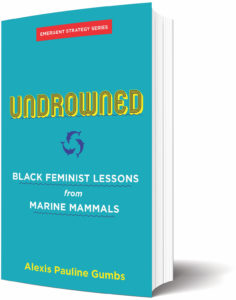Alexis Pauline Gumbs describes herself as a “queer Black feminist love evangelist and marine mammal apprentice” in Undrowned: Black Feminist Lessons From Marine Mammals, published this past November. The description might at first strike some readers as cockamamie. But — hang on, slow down, listen, and breathe. Follow such steps for self-care and enlightenment from this prolific young activist and poet, and the payoff will be real for all who love the ocean, worry about climate change, and hunger for equality.

Gumbs has earned respect as an accomplished scholar. She holds a B.A. from Barnard and a Ph.D. from Duke University. Her academic focus has been on the works of black, queer writers Audre Lord, June Jordan, and Lucille Clifton.
She has also gained a following for her activism, which, the website for Duke’s English dept. explains, includes the Mobile Homecoming Project, “an experiential archive amplifying generations of Black LGBTQ Brilliance” and Eternal Summer of the Black Feminist Mind, “an all ages intergalactic school that operationalizes black feminist texts as resources for contemporary planetary evolution!” Gumbs counts as a mentor and ally adrienne maree brown (lower case intended), who has argued in Pleasure Activism: The Politics of Feeling Good that systemic change comes when we prioritize collaboration, interdependence, and connections to both a woman-centered “ancestral past” and the natural world. Undrowned is the second volume in brown’s Emergent Strategies Series with California-based AK Press.
Steeped in scholarship and activism, Gumbs balked when she read two popular guides to marine mammals, one put out by the National Audubon Society, the other by the Smithsonian. She was put off by “languages of deviance and denigration.”
For example, she took exception with descriptions of young members of mammalian pods as “vagrant juveniles.” She didn’t like the way writers insisted on “binary assignments of biological sex,” especially when they also provided evidence of lasting same-sex relationships and multi-generational, single-sex pods. She began with an affinity for marine mammals, wanting to know “which whale was which,” and wound up “confronted with the colonial, racist, sexist, heteropatriarchalizing [sic] capitalist constructs that are trying to kill me — the net I am already caught in, so to speak.”
In Undrowned, Gumbs has written a different kind of guidebook — one that is poetic and associative. She offers 19 dense, short chapters, each a meditation on characteristics she admires in whales, dolphins, and seals — and a few sharks and manta rays thrown in for good measure. The titular “undrowned” are the descendants of enslavement who have survived the ravages of capitalism, as well as current activists who refuse to be drowned out by systems that dishonor and devalue them. The way that Gumbs plays with terminologies, characteristics, and histories mostly makes Undrowned a delight to read. The farther out she goes with her associations (the Amazon, Indus River dolphins, coparenting, love, rest, anger), like a musician riffing on a groove, the more fun it becomes.
She begins each chapter with a somewhat straightforward description of her project, aiming to mimic the performance of scientific objectivity. She then takes flight, allowing her mind to generate meaningful metaphors. On the subject of dolphins’ reliance on echolocation, for instance, Gumbs challenges readers to listen deeply to one another, even when our destinations are difficult to see or imagine.

In “Refuse,” Gumbs thinks about marine mammals who have successfully avoided observation and capture. She notes that descendants of the Atlantic slave trade, such as ruthlessly hunted Atlantic gray whales, have not disappeared, even though scientists presumed their extinction. How did the whales survive? “I call it wisdom,” Gumbs writes. “The inner capacity that allows a mammal to breathe undetected on a world such as this.” Each chapter ends with praise and love addressed to “you” — marine mammals, oceans, readers.
Though Undrowned is refreshing and even humorous in its candor, it can, at times, prove frustrating to read. Because each chapter follows the same structure, sometimes circling back over material, the book can feel repetitive. Gumbs suggests readers sample and savor chapters. She provides ideas for activities and reflections at the end of the book. I agree with Gumbs: sip, don’t gulp.
Another frustration comes from Gumbs’s wholesale dismissal of science and scientists because of participation in racist, patriarchal systems of oppression. What might teams working at Woods Hole Oceanographic Institution, Wild Care, or the Center for Coastal Studies make of such assertions? Gumbs writes that she aims her book at “dreamers that live near the shore and wonder about the whale bones you find.” She also aims it at the type of people who are lobbying the U.N. about deep ocean ecology, who cry reading the daily news, and who are worried about the climate and want peace: “Yes, you and me, the ones who thought our practice of looking at pictures of marine mammals was completely separate from our economic justice work. This is for all of us. You are on my mind and in my heart.” Surely there’s room in this subset of humanity for a scientist or two?
